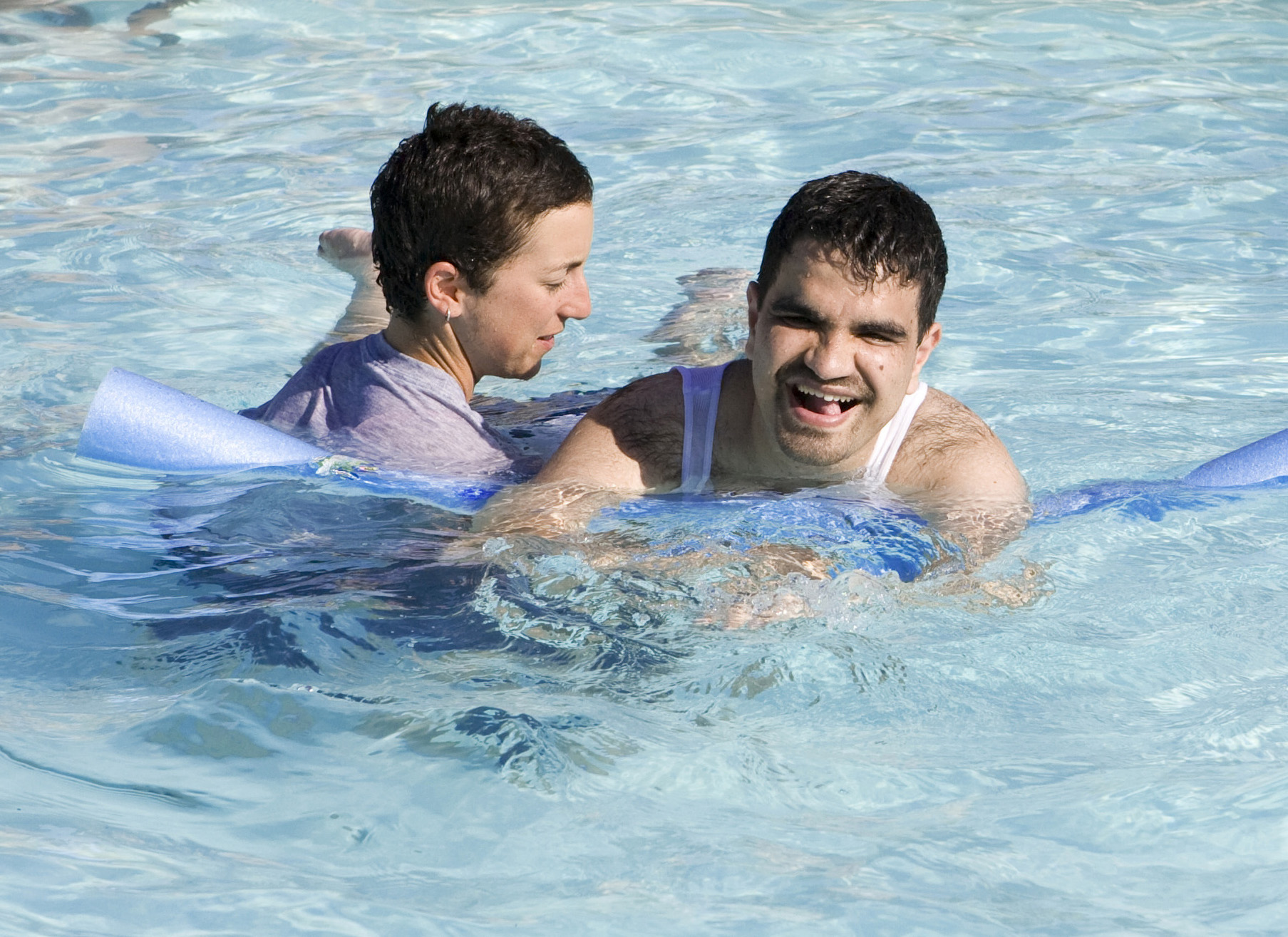HCT offers comprehensive Aquatic Therapy services to children and adults affected by Cerebral Palsy, Autism Spectrum Disorder, Traumatic Brain Injury, Elder Care Needs, Post-Surgical Rehabilitation Needs, Athletic Conditioning Needs, and other medical concerns. Aquatic therapy offers an environmental advantage to clients pursuing a wide variety of physical and psychological goals. Through the use of water’s low-gravity environment clients are able to relax, move, and have fun all while experiencing reduced stress on the body’s muscular-skeletal system. For an overview of Aquatic Therapy services offered by HCT and to learn how to begin these services please explore the following list of key questions and answers.
What is Aquatic Therapy?
Aquatic Therapy refers to treatments and exercises performed in water for relaxation, fitness, physical rehabilitation, and other therapeutic benefits. The term encompasses a diverse spectrum of methods and techniques including physical therapy, aquatic exercise, and movement-based therapy in water. Aquatic Therapy is performed while clients are either floating or partially submerged in water.
Aquatic Therapy can support restoration of movement and function, which is especially beneficial for treatment plans where limited or non-weight bearing activities are preferred, or when normal movement is limited by range of motion, inflammation, pain, or muscle spasms. The greatest advantage of Aquatic Therapy is the support provided by the water. This support helps to alleviate pressure and pain on the joints during movement while providing resistance to movement, which can be used to promote circulation and strengthen muscles and tendons. The human body’s weight is comprised of more than 50 percent water. Being in water can reduce a person’s body weight by nearly 90 percent which allows for more movement while alleviating stress on the muscular-skeletal system. The controllable environment created by water most notably allows for the re-education of weak muscles; it also provides an apt setting for skill development for neurological and neuromuscular impairment and/or injury, as well as recovery from recent surgery.
What do Aquatic Therapists do?
Aquatic Therapists bring their focus on mobility and range of motion into the water, to personally implement fitness or recovery plans for clients. They work closely with the client to assess current abilities and determine which modalities and aquatic components would offer the most benefit. The Aquatic Therapist constructs a treatment plan based on a client’s capability and goals, which is intended to affect gradual yet noticeable improvements to the client’s physical abilities and quality of life.
What clients do Aquatic Therapists serve?
HCT’s Aquatic Therapists serve a wide range of clients with special needs, including children and adults with Cerebral Palsy, Autism Spectrum Disorder, Traumatic Brain Injuries, Post-Surgery Rehabilitation, and the Elderly. Aquatic Therapists will design a customized aquatic treatment plan based on the client’s capabilities and goals, which is intended to affect gradual yet noticeable improvements to the client’s physical abilities and quality of life.
How are Aquatic Therapy Services different from other types of therapy?
Aquatic Therapy services are different from other services provided by HCT in that Aquatic Therapy happens in the water. While other methods and modalities are certainly beneficial toward meeting a client’s needs and improving their quality of life, the environment of being in the water is unparalleled for its benefits in supporting independent movement and offering the experience of stability for the client while performing various exercises and movements.
What are the benefits of Aquatic Therapy?
The Physical Benefits of Aquatic Therapy:
- Improved movement and physical function
- Increased awareness of the body and physical capability
- Improvement of fine and gross motor function
- Improved muscle tone and function
- Stimulated circulation and cardiovascular function
- Easing of chronic joint stress and pain
- Increased flexibility and range of motion
- Improved endurance
Aquatic therapy can also have a profound psychological benefit for clients. The soothing and detoxifying qualities of the water can promote a sense of euphoria, and the ease with which movement is facilitated in the water can greatly benefit a client’s self esteem through accomplishment and mastery of the exercises and modalities in the pool.
The Psychological Benefits of Aquatic Therapy:
- Increased confidence
- Pain and stress relief
- Positive reinforcement
- Focus on relaxation
- Socialization
- Improved Self-esteem
What are an Aquatic Therapist’s Education, Qualifications, and Credentials?
HCT’s Aquatic Therapists are certified Lifeguards well-versed in water safety, risk management, and physical therapy techniques which can be performed in water. As trained and certified Massage Therapists, Aquatic Therapists take their knowledge of various modalities and optimal physical functioning to the water to benefit clients in a low-impact and restorative environment. All of HCT’s Aquatic Therapists are state licensed Massage Therapists, insured, and CPR certified.
What is the process for receiving Aquatic Therapy Services from Health Care Therapies?
In order to receive Aquatic Therapy services from HCT a client evaluation must first be scheduled. An HCT therapist will meet with the client and their family to discuss the client’s overall health as well as their capabilities, goals, and challenges they experience. After the initial client evaluation, HCT therapists work with the client as well as the client’s family and doctors to create a comprehensive treatment plan that will benefit the client to help them reach their goals. The customized treatment plan may feature various components including Massage Therapy, Recreational Therapy, Music Therapy, and Aquatic Therapy. The aquatic components of a client’s treatment plan are performed in a swimming pool and feature a series of supervised exercises which include stretching and coordinated movements, often with the use of a floatation device or life jacket. The aquatic treatment plan is designed to gradually expand an individual’s strength, coordination, flexibility, stamina, and other measurable goals. The ultimate goal of a successful aquatic treatment plan is to help the client eventually learn to replicate or repeat the exercises and movements learned in the water on land – greatly improving the client’s independence and quality of life.
The exercises include, but are not limited to:
- Shallow walking or running in knee- or ankle-deep water
- Deep water walking or running with broad strides while standing in chest- or waist-deep water
- Kicking against water while holding onto the side of the pool
- Ai chi (water-based tai chi)
- Swimming
- Water-based yoga



